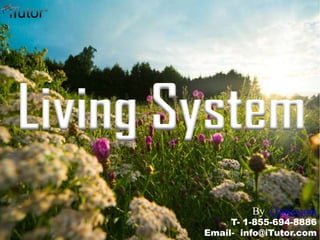
Living System
- 1. Living System T- 1-855-694-8886 Email- info@iTutor.com By iTutor.com
- 2. An organism is an individual form of life. Biologists often use five basic rules to classify something as living or nonliving. Yeast is a living organism. Each tiny sphere is an individual living thing.
- 3. 1. All living things respond to a stimulus. The sunlight is a stimulus and the frog’s choice to sun himself is called a response. 2. All living things take materials from their surroundings such as food, water, and gases and use these materials to get energy. 3. Growth refers to an increase in mass and to an increase in number of cells. 4. The process of making more of the same kind of organism is called reproduction. 5. A cell is the smallest unit of a living thing.
- 4. This is a barnacle. Read about the five characteristics of life Then decide whether it is alive. 1. Barnacles respond to their environment by closing their shells at low tide, and opening them at high tide. 2. Barnacles grow and develop. They begin life as free-swimming creatures. Once they find a good spot, they “glue” themselves to a rock and form a shell. 3. Barnacles reproduce. After fertilization from a male barnacle, females hold the eggs in their shells until they hatch. 4. By waving their legs, barnacles capture food. They use energy from the food to move their legs, open and close their shells, and carry out all life processes. 5. If you examined the legs of a barnacle with a microscope you would see that they are made of individual cells.
- 5. Energy is sometimes defined as the ability to cause change or do work. There are many forms of energy. Any form can be converted into any other form.
- 6. • As a living system, your body is organized to use matter and energy to move, grow, and survive.
- 7. • Living systems are made of many different molecules. • A molecule is a basic unit of matter. • Your body contains molecules that store energy, control life functions, and that even hold all of the information needed to make another you! How are you different from this one- celled organism?
- 8. • Living systems—like you—contain many levels of organization. – A cell is the basic unit of a living system. – A group of specialized cells that performs a particular function is called a tissue. – An organ is a group of tissues that works together to carry out a set of functions. – A group of organs that works together to perform a set of functions is called an organ system.
- 11. Living things can respond to changes in their surroundings to maintain a steady internal environment. The process of maintaining a life- supporting system is called homeostasis.
- 12. All sorts of variables affect an organism’s ability to stay alive. These include temperature, food, water, and the level of oxygen. All organisms have built-in processes to help them survive when variables change. Your normal body temperature is 37°C. How does sweating or shivering help you maintain a constant body temperature?
- 13. In 1996, some scientists made a startling claim. They said that they had evidence suggesting that life existed on Mars more than 3 billion years ago. Is there proof for life on Mars?
- 14. The End Call us for more Information: www.iTutor.com Visit 1-855-694-8886